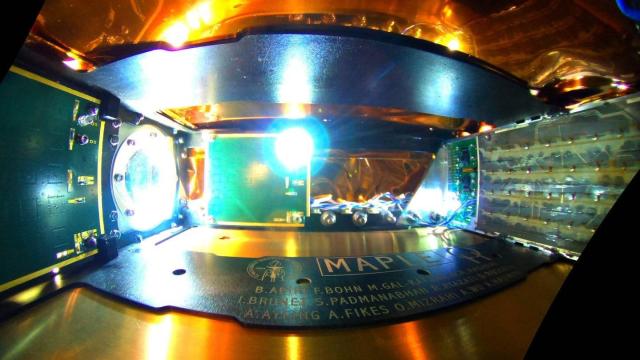The California Institute of Technology has big news for space-based power. Researchers at the university have reportedly beamed solar power from space to Earth without a single wire — and they say it’s a first.
The experiment is a part of Caltech’s Space Solar Power Project, and the institute announced a successful transmission via press release yesterday. The researchers conducted the power transfer experiment using the Microwave Array for Power-transfer Low-orbit Experiment, or MAPLE, which is a small prototype aboard the in-orbit Space Solar Power Demonstrator (SSPD-1) that launched this past January.
The researchers say that, in a first, MAPLE’s array of transmitters successfully beamed solar power collected in space using microwaves to a receiver on the rooftop of Gordon and Betty Moore Laboratory of Engineering on Caltech’s campus in Pasadena.
“Through the experiments we have run so far, we received confirmation that MAPLE can transmit power successfully to receivers in space,” said Space Solar Power Project co-director Ali Hajimiri in the press release. “We have also been able to program the array to direct its energy toward Earth, which we detected here at Caltech. We had, of course, tested it on Earth, but now we know that it can survive the trip to space and operate there.”
The SSPD-1, attached to a Vigoride spacetug from Momentus Space, consists of two panels used to collect solar power. An array of transmitters within MAPLE sends that energy across a given distance using constructive and destructive interference. Located about a foot away from its transmitter, MAPLE has two receivers that collect solar energy and convert it to DC electricity which, during the experiment, was used to light up two LEDs inside MAPLE. The researchers were able to light up one LED at a time by shifting the transmissions between the receivers, demonstrating the accuracy of the array. MAPLE also has a window that can allow the transmitters to beam energy to a target outside the spacecraft, like Earth.
“In the same way that the internet democratized access to information, we hope that wireless energy transfer democratizes access to energy,” Hajimiri said in the release. “No energy transmission infrastructure will be needed on the ground to receive this power. That means we can send energy to remote regions and areas devastated by war or natural disaster.”
The ability to wirelessly transmit solar power from space has huge implications for renewable energy, so much so that Japan plans to start using it by the mid-2030’s. A Japanese research team is looking to pilot the technology in 2025 with a public-private partnership.
As humanity’s growing need for energy continues, a powerful solution like space-based solar power collection and transmission could be a huge step in the right direction. Space-based power collection would be able to operate 24-hours a day — whereas night pauses ground-based solar power collection — and would be to able to beam power to remote or disaster-stricken areas, assuming they have the requisite infrastructure.
